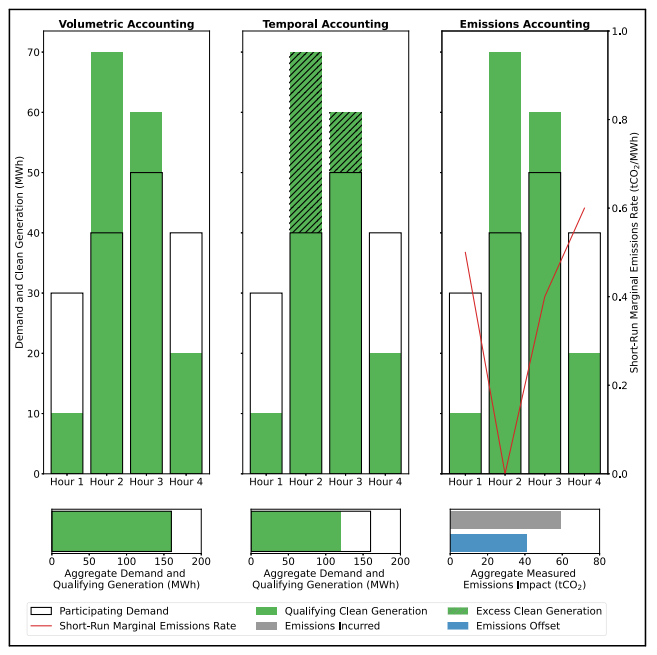Academic Sharing|At Joule, Dr. Xu Qingyu Publishes a Paper Titled “System-level Impacts of Voluntary Carbon-free Electricity Procurement Strategies”
Xu Qingyu, Shuimu Scholar, Postdoctor at the Department of Electrical Engineering of Tsinghua University, and a member of Energy Governance Research Centre at EIRI, has published a paper titled “System-level Impacts of Voluntary Carbon-free Electricity Procurement Strategies” at Joule. The paper explores the potential impacts on carbon emissions, costs, and installed generation capacity of organisations (corporations, governments, and universities) widely adopting different voluntary carbon-free electricity procurement strategies across the electricity system.

Organisations attempt to reduce carbon footprint of electricity consumption and declare the realisation of “zero emissions from electricity consumption”, by utilising voluntary carbon-free electricity procurement (mostly referred to as green power and green certificate consumption in China). However, the declaration of zero emissions does not mean the actual emission reduction effect has been really made. As a matter of fact, there are various definitions of “zero emissions from electricity consumption” and corresponding voluntary carbon-free electricity procurement strategies internationally. This paper deeply explores and inspects the most widespread 3 procurement strategies which are said to be capable of achieving “zero electricity carbon emissions”:
Strategy 1 - Volumetric Accounting: The total amount of carbon-free electricity/certificates procured by the organisations (or the total electricity generation corresponding to the power purchase agreement) ≥ total electricity consumption
Strategy 2 - Temporal Accounting: Carbon-free electricity/certificates procured by organisations are matched at a finer time granularity (e.g. hourly level) to ensure that the carbon-free electricity/certificates after temporal accounting are ≥ the total amount of electricity consumed.
Strategy 3 - Emissions Accounting: Organisations calculate the carbon reduction benefit by calculating the product of the Carbon-free Electricity/Certificate and the marginal emission factor, and at the same time ensure that the carbon reduction benefit is greater than their own carbon footprint of electricity consumption to complete the carbon offsetting.

Figure: Schematic representation of the three accounting approaches and their corresponding strategies for voluntary carbon-free electricity procurement: Volumetric Accounting (left), Temporal Accounting (centre), and Emissions Accounting (right).
Based on the open-source power system planning model and the market simulation software GenX, the paper investigates and evaluates the impacts of voluntary carbon-free electricity procurement by commercial and industrial users on the power system in the western region of the United States. The results show that: i. A carbon-free electricity procurement strategy of the annual volumetric accounting has little carbon reduction benefit; ii. A strategy based on short-term emission accounting has similarly limited effects; iii. Temporal accounting of purchases can lead to significant reductions in carbon emissions at the system level, but the strategy is more costly; and iv. Temporal accounting of purchasing strategies can increase the market share of flexible and reliable clean power generation technologies as well as long-duration energy storage technologies. In addition, an increase in the government’s mandatory clean power standard (approximated in China as a renewable energy consumption weighting mechanism) could also improve the economic efficiency of all voluntary carbon-free power procurement.
Although the results and discussion are based on U.S. data, the methodology and results of this paper are also instructive for China’s corresponding analyses and mechanism design, as the international environment has increased the disclosure requirements for China’s electricity consumption (e.g., Europe’s Carbon Boundary Adjustment Mechanism (CBAM) and the New Battery Law), and Chinese companies are in urgent need of a complete set of electricity consumption carbon awareness and green power (certificate) mechanisms to reduce carbon emissions. The answer to the question of what kind of green power procurement strategy (or mechanism) is suitable for China’s major electricity users, especially the export product industry, which can achieve the actual emission reduction effect and obtain international recognition without significantly pushing up the cost of the products, urgently needs relevant research.
The first and corresponding author (ranked first) of the paper is Xu Qingyu, a postdoctor at EIRI, Tsinghua University; the co-author is Wilson Ricks, Princeton University; and the lead contact is Jesse D. Jenkins, Princeton University.
Joule is the first energy flagship journal under Cell Publishing, and is positioned as a twin journal of the renowned Cell, with an impact factor of 39.8. Since its inception, Joule has gained wide attention and recognition in the international academic community, and mainly contains high-level research results in energy-related fields.
Link to the papar:
https://www.cell.com/joule/fulltext/S2542-4351(23)00499-3
Recommended Reading:
Ricks, W., Xu, Q. & Jenkins, J. D. Minimizing emissions from grid-based hydrogen production in the United States[J/OL]. Environ. Res. Lett. 18, 014025, 2023. DOI: 10.1088/1748-9326/acacb5.
Giovanniello, M.A., Cybulsky, A.N., Schittekatte, T. et al. The influence of additionality and time-matching requirements on the emissions from grid-connected hydrogen production[J/OL]. Nat Energy, 2024. DOI: 10.1038/s41560-023-01435-0
张宁,李姚旺,黄俊辉,李瑶虹,杜尔顺,李明轩,刘昱良,康重庆.电力系统全环节碳计量方法与碳表系统[J].电力系统自动化,2023,第47卷(9): 2-12. DOI:10.7500/AEPS20221021001
李姚旺,刘昱良,杨晓斌等.计及电量交易信息的用电碳计量方法[J/OL].中国电机工程学报,1-12[2024-01-17]. DOI: 10.13334/j.0258-8013.pcsee.222323.